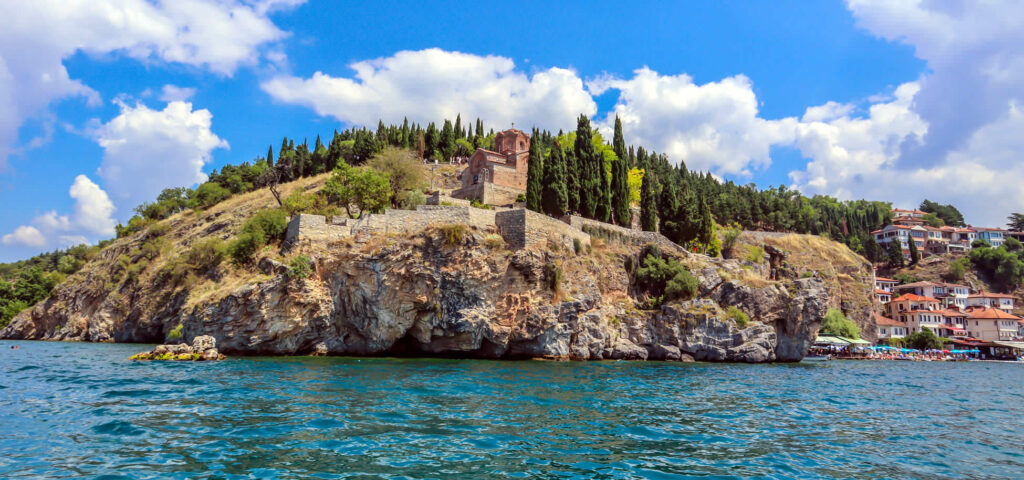NORTH
MACEDONIA
North Macedonia, officially the Republic of North Macedonia, is a country located in the Balkan Peninsula in Southeastern Europe.
North Macedonia has borders with Kosovo to the northwest, Serbia to the northeast, Bulgaria to the east, Greece to the south, and Albania to the west.
The greater part of North Macedonia (about nine-tenths of its area) drains southeastward into the Aegean Sea via the Vardar River and its tributaries. Smaller parts of this basin drain into Lake Doiran (Macedonian: Dojran) and into the Aegean via the Strumica and Struma rivers. The remainder of North Macedonia drains northward via the Crni Drim River toward the Adriatic Sea.
Successive waves of migration, as well as economic and political modernization, have left their mark in a diversity of settlement patterns. The inhabitants of the highlands are generally shepherds. In more fertile areas, small-scale subsistence and market-oriented agriculture are practiced. Several small market towns are of great antiquity. In Roman times Bitola was a commercial centre known as Heraclea Lyncestis. Ohrid became a major administrative and ecclesiastical centre in the early Middle Ages. The coming of the Ottoman Turks in the 14th century promoted the growth of Skopje as a governmental and military centre and created large agrarian estates.
Well, the capital of North Macedonia is Skopje.
The population of the Republic of North Macedonia is diverse. At the beginning of the 21st century, nearly two-thirds of the population identified themselves as Macedonians. The rest of population are: Serbs, Turkish, Roms(Gypsy), Bosnians, Albanian.
Skopje
Skopje is the capital of North Macedonia, located at the crossroads, lying on the Vardar river. It has about half a million inhabitants.
Diving into the historic Čaršija (Old Ottoman Bazaar) of North Macedonia’s friendly capital, seeking out its modernist architecture and marvelling at the supersized riverside monuments.
The most famous monument in Skopje is the Kale Fortress, located on the Gradiste hill, above the Vardar River. The first fortress was built in the 4th century. The main attraction of Skopje is the Stone Bridge, or Dusan’s Bridge, which connects the new and old part of the city across the Vardar RiverThe Mother Teresa Memorial House is also located in Skopje, her hometown. It was opened on the centenary of her birth in the place where the Catholic Church of the Holy Heart of Jesus used to be. In addition to the numerous bridges and museums in the old part of the city there is a huge market-Bit Bazaar which is one of the few places that has preserved the spirit of Old Skopje.
Lake Ohrid

Lake Ohrid, straddles the mountainous border between southwestern Macedonia and eastern Albania. It is one of Europe’s deepest and oldest lakes, preserving a unique aquatic ecosystem that is of worldwide importance, with more than 200 endemic species. The importance of the lake was further emphasized when it was declared a World Heritage site by UNESCO in 1979 and when, in 2010, NASA decided to name one of Titan’s lakes after Lake Ohrid. The towns situated at the lakeside are Pogradec in Albania, along with Ohrid and Struga in Macedonia.
Being the largest and most beautiful out of Macedonia’s three tectonic lakes, Lake Ohrid is about 30 kilometers (18 miles) long and round 288 meters (945 feet) deep. Its astonishingly clean and clear waters, together with the serene stillness of its mountain settings have captivated visitors since prehistoric times. While the lake is filled up by water from three rivers, most of Ohrid’s water comes from another lake – Prespa which is located on the other side of Mountain Galicica. With its unique flora and fauna characteristic of the tertiary period (2-4 million years ago), Ohrid is one of Europe’s great biological reserves. Most of the lake’s plant and animal species are endemic and unique to Ohrid. The most famous among these are two types of the Ohrid trout, named letnica and belvica. Other unique Ohrid creatures include two types of eel, and the bleak whose scales are used for making the well-known Ohrid pearl. This treasured jewel is produced according to a secret method which was passed on from generation to generation. Sport fishing attracts many passionate fishermen from Macedonia, Europe and even from the world.
Stone Dolls
Kuklica, village located near to Kratovo (Кратово) is home to these gigantic figures, over a hundred in total and ranging in height from 2 to 9 meters. Kuklica is located 8 km northwest of Kratovo. These rock formations are commonly referred to as Stone Dolls (Камени Кукли, Kameni Kukli). There are different theories behind the formation of these figures.
The stone town is an area consisting of naturally formed stone pillars. The stone formations are situated on the right bank of the Kriva River valley. The area has an altitude of 415-420 m and extends over an area of 0.3 square km.
Kuklica is also known as, the Wedding party, the Valley of Dolls, or Stone Town.

